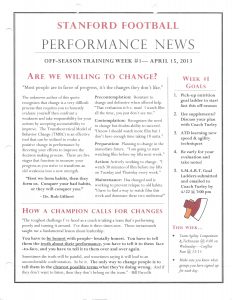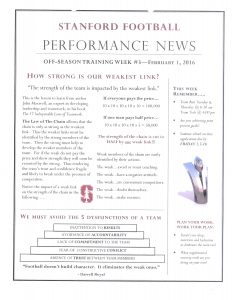James Lowery
Every organizational leader faces change on a daily basis and must find a way to incorporate a change mechanism into the culture of the business. Brave, competent leaders are the engine that drives the change mechanism. Without the ability to adjust, adapt, and overcome problems the team will certainly be left behind by the competition or cease to exist.
Change or Die (Deutschman, 2007) examines a life or death situation and considers whether a person can make the decisive, attainable, and vital changes to current lifestyle to save a life. Deutschman explains that in a life or death situation a person probably could not change. The concept applies to saving the life of an organization or team. Leaders implementing change will almost always have to confront resistance. Resistance hides the individual’s fear of change or lack of trust in the leader to make real change happen. Every team will face transform or else situations. Veteran leadership must be able to navigate the change process and overcome resistance. Great leaders use the best leadership style based on the situation while knowing when and where to apply a particular style.
Organizational leaders must realize the company itself, the employees, and the markets served are all dynamic. Two distinct situations can affect leadership within a team or organization: leadership during change and during the status quo. Transformational Leadership concerns initiating change in a team or organization. For a team or organization to change, the members must begin to do things differently. Change is often challenging and uncomfortable for those who make the changes because team members must perform outside of a comfort zone. Transactional Leadership is the second situation facing a team or organization. This is a leadership that keeps things operating the same way things always have been or the status quo. Leaders who operate in the transactional mode often find the company in crisis mode. A leader operating in the status quo for too long will place his followers in danger of either being left behind by the competition. A leader must embrace the idea that change is inevitable and build change mechanisms into the culture of the organization.
Change must align with the organization’s culture, values, people, mission, and purpose to be successful. The key is building the desire to change and the acceptance of change into the culture and the values. Culture dictates how people think and act when forced to confront change. Attempts to force transformation onto employees will not be successful. This approach only leads to employee resentment and distrust of the leaders in the company. Followers are always very fearful of decisions made without input. Leaders must offer change to the employees and allow active participation in making the changes happen. Leaders must trust and empower employees to create the necessary change. Information and ideas must flow freely between leaders and followers. Leaders and followers actively seek and obtain the opinions of others, communicate openly and always ask for feedback. Some information may be hard to hear, but this information will allow everyone to see reality. Team members should follow the mission and purpose of the organization and inspire the members.
Leadership style is how a leader provides direction to the team, implements change, and motivates people to accomplish changes. Servant leadership philosophy says excellent leaders work to serve the team, not to have the team serve the leader. Very few aspiring leaders realize that a leader is a servant’s role. To facilitate change that becomes a lasting part of the company culture, a leader must stand behind followers ready to serve and ready to help fill the teams every need so that the team succeeds. A leader must set aside ego and try not to be the center of attention or followers will feel management is trying to force change onto the followers. Followers are less likely to accept change in this situation. The focus is not on the leader, but on how the team will work together to succeed. A title makes someone the leader; the team will decide if someone is a leader. Leading from behind is not a weakness, but strength.
Employees should adopt a learning culture. Employees can learn from each other and customers and then use that knowledge to improve company performance. Adapting a servant leadership style that allows and encourages followers to succeed, will provide team members with the positive experiences needed to abandon the old beliefs and become comfortable with change as the new norm
One of the most memorable leadership and change experiences came with the Iowa State Cyclone football team. The old head coach was fired, and a new, young, eager leader hired, Coach Matt Campbell. Iowa State had been at the bottom of the Big 12 Conference football standings for as long as anyone could remember. No one expected the new coach to work miracles overnight. Witnessing the change from the Strength and Conditioning vantage point was enlightening. Unfortunately, graduation would allow only one year of enlightenment.
Before 2016, Iowa State Football culture centered on a caring relationship between the coaching staff and players. The coaches were the player’s friends and not leaders. The arrival of Coach Campbell brought immediate change. The coaches were now teachers and leaders, not friends. Many meetings were held to present the players with Coach Campbell’s vision of the future and what the player expectations would be. Accountability for actions and performance were keys to becoming a contender in the Big 12. Surprisingly, most of the players were quite receptive to the new vision and jumped on board despite the harder work.
Coach Campbell used many leadership styles during that first year. The coach was a dictator at times who demands the team perform in a certain way and a servant at other times who allows the players input into the situation. Great leaders use the best leadership style based on the situation while knowing when and where to apply a particular style as needed.
A leader can successfully drive change for one project, but this does not mean all of his followers have the desire to transform and the acceptance of change into the culture.
Despite some successes, leaders may find many people still resist. Followers will cling to current beliefs and will not readily accept the new success story. Under-performing scholarship players at Iowa State, who oppose change, soon found themselves looking for a new team.
Leaders must continue to create experiences for all followers in which successful transformation benefits the team and followers propel the change, not the leader. In Coach Campbell’s first year, the team only won three games but narrowly lost to top teams like Baylor, Texas Christian and Oklahoma. In fact, one could argue Iowa State should have won a couple of those games. The change in culture created the positive experiences that were instrumental in convincing followers the team was headed in the right direction and change was good.
Other leadership and change situations experienced over the years include working with football teams who stood at opposite ends of the winning spectrum. One team holds the current NCAA Division I losing streak record in 2012 and the other team was the 2016 Rose Bowl winner. Both of these teams had one thing in common, the desire to change. New Mexico State owns the longest losing streak in NCAA Division I in. The coaching staff undertook a mission to change the culture of the football program and end the losing ways. The team began by reading Change the Culture, Change the Game (Connors and Smith, 2012). Enough copies were purchased and given to all players. The whole football team read a chapter every week, followed by Mindset: The New Psychology of Success (Dweck, 2016). In this case, a change was introduced weekly but in a way that let the team determine if players would adapt to the change or resist. By 2015 the team shot up to a three-win season and four wins in 2016. During the 2017 season, the Aggies have four wins already with four games to play.

Figure 1
The 2016 Stanford football team, under head coach David Shaw, convincingly won the Rose bowl over the Iowa Hawkeyes. Stanford is no stranger to success but is always looking for more success in the future. Reading “Stanford Football Performance News” (Stanford Football, 2013) was mandatory in the off-season. The newsletter had to be read and understood by the football team (see Figure 1). All players received a new copy of the “Stanford Football Performance News” (see Figure 2) every Monday during team workouts. Each week introduced a different change topic that, if adopted, would improve team performance. Individual players who could demonstrate this change throughout the week were rewarded. Each Friday a quiz was given on the concepts presented. Winners of the quiz contest watched the losers perform extra work during practice.
 Figure 2
Figure 2
Building the desire to change and the acceptance of change into the culture and the values of the company will provide the difference between surviving in a dynamic environment or ceasing to exist. A built-in change mechanism will give the company a competitive advantage in the market and provide game-changing results. Performance improvements are extremely challenging to achieve in a company that is managing to the status quo but are commonplace in organizations that embrace change. The change in leadership and culture in the Iowa State Football program has continued during the 2017 season. The Cyclones have now defeated two top five teams and boosted the team record to six wins so far this season. Continuous change has kept Stanford Football in the national spotlight and change at New Mexico State is leading the way into a winning future. Coach Shaw recognized that if Stanford was going to stay on top of the competition, the team had to embrace change.
Since Stanford was the dominant football program, every other team focused on beating the champions. Stanford football needed a system of continuous change to stay on top. Staying the same will lead to stagnation, opponents will catch up and surpass you. Because of this, Coach Shaw introduced change and adversity every single week in the form of “Stanford Sports Performance News.”
References
Connors, R., & Smith, T. (2012). Change the culture, change the game: the breakthrough strategy for energizing your organization and creating accountability for results. New York: Portfolio Penguin.
Deutschman, A. (2007). Change or die. New York, NY: HarperCollins.
Dweck, C. (2016). Mindset: the new psychology of success. New York: Ballantine Books.
Stanford Football Performance News, 1, 1. (2013, April 15). Are we willing to change? Stanford, CA: Stanford University.
Stanford Football Performance News, 3, 1. (2016, February 1). How strong is our weakest link? Stanford, CA: Stanford University.
